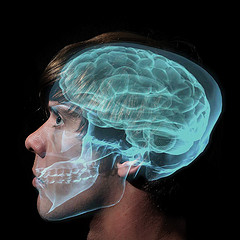talking with faculty about cognitive science & learning (pod essays on teaching excellence)
cft assistant director nancy chick previews an essay by john girash, harvard university, appearing in essays on teaching excellence published by the professional and organizational network in higher education.
in “talking with faculty about cognitive science & learning,” one of the essays in pod’s new essays on teaching excellence, john girash of harvard connects the brain research relevant to introducing students to new ideas to talking about it with faculty who are unfamiliar with this kind of research. most useful are the nuggets of research he highlights as applicable to teaching across the curriculum.
 did you know that the brain itself poses real challenges to learning? girash points out that the neurons in a novice’s brain are fired up with the heavy cognitive load, while an expert’s brain is less so, evidence of how much of the brain is engaged with the task of learning new ideas. such research has real implications for lesson design and classroom activities. for instance, the number of ideas we can work with at once (working memory) is limited to seven or eight,* so introducing too many new concepts at once will exceed the brain’s abilities. also, for learners to be able to use, apply, and retain new ideas, these ideas must first be connected to something the learner already knows (mirroring the physiological connections the brain actually makes in the learning process), and then “rehearsed,” practiced, restated, or actively kept in the working memory for sustained periods in a variety of ways. finally, when a learner feels some emotion—any emotion—about an idea, more neurons are fired, more of the brain is involved, and thus more of the idea is retained, which speaks to the importance of attending to affective dimensions of learning.
did you know that the brain itself poses real challenges to learning? girash points out that the neurons in a novice’s brain are fired up with the heavy cognitive load, while an expert’s brain is less so, evidence of how much of the brain is engaged with the task of learning new ideas. such research has real implications for lesson design and classroom activities. for instance, the number of ideas we can work with at once (working memory) is limited to seven or eight,* so introducing too many new concepts at once will exceed the brain’s abilities. also, for learners to be able to use, apply, and retain new ideas, these ideas must first be connected to something the learner already knows (mirroring the physiological connections the brain actually makes in the learning process), and then “rehearsed,” practiced, restated, or actively kept in the working memory for sustained periods in a variety of ways. finally, when a learner feels some emotion—any emotion—about an idea, more neurons are fired, more of the brain is involved, and thus more of the idea is retained, which speaks to the importance of attending to affective dimensions of learning.
this research, even for those well outside of the sciences, is relevant to our work with students and other learners, as it may help us understand moments of their confusion, frustration, forgetfulness, error, and mislearning.
* the exception to the limits of working memory occur when we use both oral or written text and visual images, in essence doubling the brain’s capacity since these two types of language use different parts of the brain. you can learn more about this effect and how to use visual and written/oral language successfully by viewing the cft’s presentation, “tell and show: why and how to use images in presentations.”
also, this episode of the wnyc’s “radio lab” podcast addresses this limit of working memory and its effect on our ability to make good choices, or our ability to apply what we know. most relevant is the “how much is too much?” segment from 2:15 to 20:30.
photo: by illuminaut

leave a response